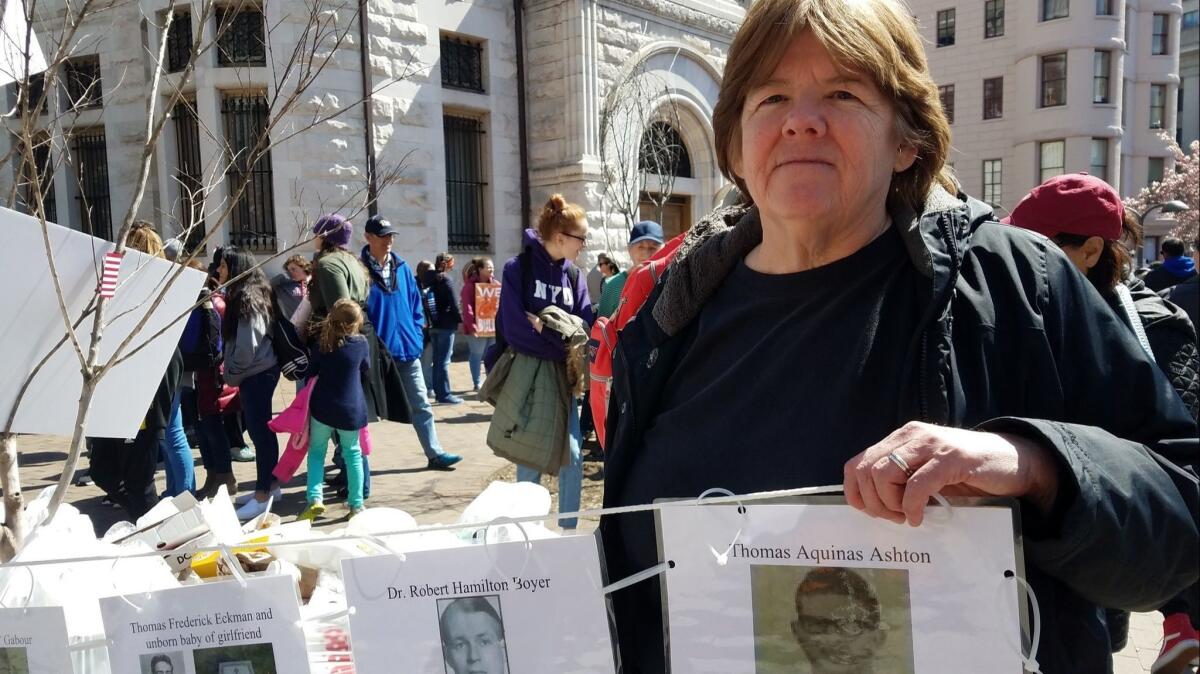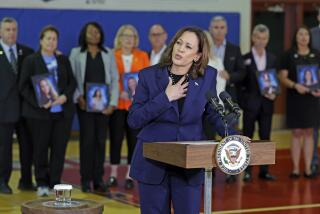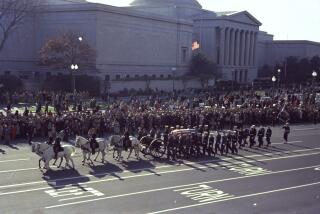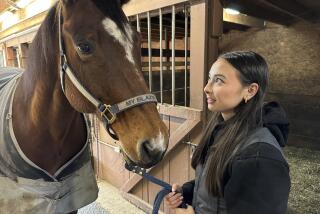With just string, zip ties and paper, one woman created a gun victim memorial that’s hard to ignore, and even harder to look at

It was just after 11 a.m. when Maureen Glover unfurled what amounted to a massive obituary, held together with white string and zip ties, near Seventh Street and Indiana Avenue.
Stretching hundreds of feet, the exhibit held more than 200 pieces of white paper, one honoring each victim who died in a mass school shooting over the the last half-century.
Glover, who was bundled in a thick, black winter coat, had brought only a few friends with her from New Jersey to help her hold up her lengthy paper chain. But as hundreds of thousands of marchers thronged around the Capitol for March for Our Lives, she had no problem recruiting volunteers.
Even in a demonstration awash in pithy slogans and powerful statements — “BOOKS NOT BULLETS,” and “THERE ARE BETTER WAYS TO REDUCE CLASS SIZE” — Glover’s effort stood out.
At the far left, the first piece of paper, laminated in clear plastic, quoted the president of the United States: “THE TIME HAS COME FOR ACTION.”
The president was Lyndon B. Johnson, and the year was 1966. One day after a former Marine stabbed his wife and mother and shot students from a tower at the University of Texas, killing 17 and injuring 29, Johnson pushed Congress to pass gun-control legislation.
“What happened is not without a lesson: THAT we must press urgently for the legislation now pending in Congress to help prevent the wrong persons from obtaining firearms,” Johnson said then.
A second piece of paper said simply: “#isyourchildnext?”
The chain then displayed a procession of portraits, starting with the last victim of a mass school shooting: Jaelynn Willey.
Jaelynn, 16, was shot Tuesday at Great Mills High School in southern Maryland by a 17-year-old former boyfriend and taken off life support just two days ago. The piece of paper honoring her included a vacation snapshot of her smiling in front of rippling, blue waves.
“I wanted people to see their faces,” said Glover, a 62-year-old fiscal operations manager from Asbury Park, N.J. “I think we’ve become desensitized.”
She stood at the opposite end of the display, sipping a Diet Coke as she held up a piece of paper honoring Thomas Aquinas Ashton, 22, who died in the University of Texas shooting.
Glover, who was 11 years old back in 1966, said the Texas incident had always stuck with her — even though she grew up more than 1,500 miles away. She remembers how her mom came out on the porch when she heard of the massacre.
“Go get Jimmy,” her mom instructed, referring to her brother. “There’s a shooting in Texas.”
“People responded back then,” Glover said. “Now you hear it on TV, and we don’t even turn around to look.”
Glover said she planned to display her massive banner across the country, not just at gun-control demonstrations, but outside the NRA’s headquarters.
“Here, I feel we’re preaching to the choir,” she said. “I want everyone to see it’s not just a number. We’re dealing with people. We can’t let one special-interest group like the NRA dictate who’s going to live and who’s going to die.”
All around her Saturday, parents pushed strollers and hoisted small children on their shoulders. Throngs of high school kids roamed, chattering as they took selfies and clutched handmade signs saying “18th century laws CANNOT REGULATE 21st century weapons” and “WHEN I SAID I’D RATHER DIE THAN GO TO CLASS I WAS JOKING.”
In the bustling crowd, many protesters lingered to look at the portraits. Some peppered Glover with questions, took photos and handed her $20 bills.
“How many victims are listed?” a woman asked after passing the line of portraits.
“More than 200,” Glover replied.
Then Glover admitted she didn’t know exactly how many names were in the chain. “Hopefully, this is the end of it,” she added. “But I said that after Parkland, and then I had to add Jaelynn Willey.”
Every few minutes, someone stopped and volunteered to hold up the exhibit.
“These young kids lost their lives,” said W. Ellington Felton, 40, a musician from Washington, who held up a portrait honoring Waleed Shaalan, 32, one of 32 people killed in 2007 at Virginia Tech. “The least we can do is hold up signs in their memories.”
As if on cue, Luke Chetelat, a graduate of Virginia Tech, stopped to ask Felton if he could take over.
He pointed to his maroon and orange college jacket.
Chetelat, a clinical assistant at a physical therapy office in Baltimore, had come to the rally holding a simple placard attached to a pole. On one side he had scrawled “PEACE” and “LOVE,” and on the other he used profanity to admonish the National Rifle Assn.
The Virginia Tech shooting occurred six years before Chetelat enrolled at the college. Its effects are inescapable. “The shooting affects everyone who goes to the school,” Chetelat said as he lifted up a piece of paper honoring Minal Panchal, 26.
Over the course of the demonstration, hundreds of volunteers took turns to carry the exhibit — some for five minutes, others for more than an hour.
Anjali Joshi, 13, a seventh-grader at Sudbrook Magnet Middle School, stood not far from her mom, Angela, holding a portrait of Rachel Scott, 17, one of 13 students who died after a shooting at Columbine High School in Colorado on April 20, 1999.
“I wanted to hold it up to show I care,” she said.
Down the line, Angela Joshi adjusted her sunglasses to wipe away tears.
“This just brings it home,” she said as she held up a picture of Chanelle Star Rosebear, who died in a 2005 shooting at Red Lake Indian Reservation in northern Minnesota. She was 15.
Jarvie is a special correspondent.
More to Read
Start your day right
Sign up for Essential California for news, features and recommendations from the L.A. Times and beyond in your inbox six days a week.
You may occasionally receive promotional content from the Los Angeles Times.







